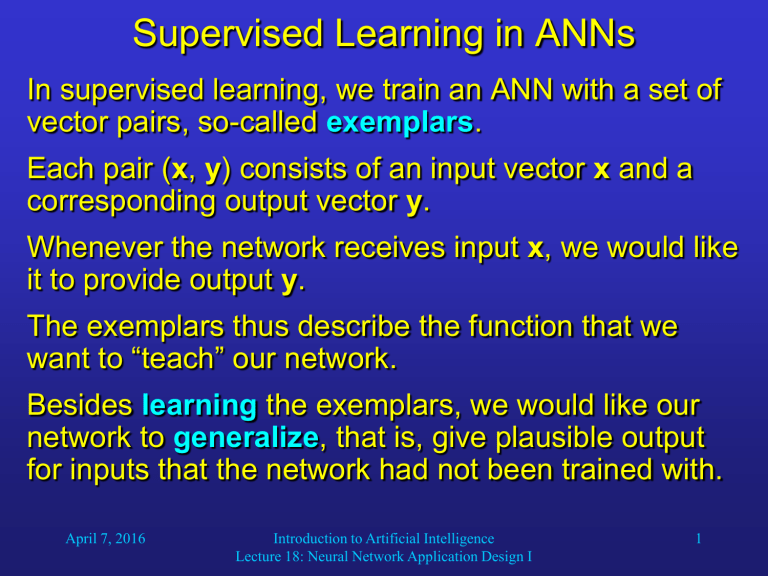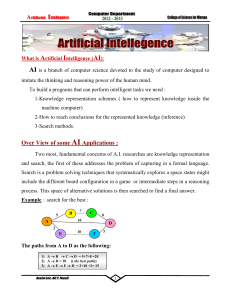Supervised Learning in ANNs

Supervised Learning in ANNs
In supervised learning, we train an ANN with a set of vector pairs, so-called exemplars .
Each pair ( x , y ) consists of an input vector x and a corresponding output vector y .
Whenever the network receives input x , we would like it to provide output y .
The exemplars thus describe the function that we want to “teach” our network.
Besides learning the exemplars, we would like our network to generalize , that is, give plausible output for inputs that the network had not been trained with.
April 7, 2016
Lecture 18: Neural Network Application Design I
Supervised Learning in ANNs
There is a tradeoff between a network’s ability to precisely learn the given exemplars and its ability to generalize (i.e., inter- and extrapolate).
This problem is similar to fitting a function to a given set of data points.
Let us assume that you want to find a fitting function f: R
R for a set of three data points.
You try to do this with polynomials of degree one (a straight line), two, and nine.
April 7, 2016
Lecture 18: Neural Network Application Design I
f(x)
Supervised Learning in ANNs deg. 2 deg. 1 deg. 9 x
Obviously, the polynomial of degree 2 provides the most plausible fit.
April 7, 2016
Lecture 18: Neural Network Application Design I
Supervised Learning in ANNs
The same principle applies to ANNs:
• If an ANN has too few neurons, it may not have enough degrees of freedom to precisely approximate the desired function.
• If an ANN has too many neurons, it will learn the exemplars perfectly, but its additional degrees of freedom may cause it to show implausible behavior for untrained inputs; it then presents poor ability of generalization.
Unfortunately, there are no known equations that could tell you the optimal size of your network for a given application; you always have to experiment.
April 7, 2016
Lecture 18: Neural Network Application Design I
The Backpropagation Network
The backpropagation network (BPN) is the most popular type of ANN for applications such as classification or function approximation.
Like other networks using supervised learning, the
BPN is not biologically plausible.
The structure of the network is identical to the one we discussed before:
• Three (sometimes more) layers of neurons,
• Only feedforward processing: input layer
hidden layer
output layer,
• Sigmoid activation functions
April 7, 2016
Lecture 18: Neural Network Application Design I
The Backpropagation Network
BPN units and activation functions:
O
1 output vector y
…
O
K f(net o )
H
1
H
2
H
3
…
H
J
April 7, 2016
I
1
I
2
… input vector x
I
I
Lecture 18: Neural Network Application Design I f(net h )
Learning in the BPN
Before the learning process starts, all weights
(synapses) in the network are initialized with pseudorandom numbers.
We also have to provide a set of training patterns
(exemplars). They can be described as a set of ordered vector pairs {(x
1
, y
1
), (x
2
, y
2
), …, (x
P
, y
P
)}.
Then we can start the backpropagation learning algorithm.
This algorithm iteratively minimizes the network’s error by finding the gradient of the error surface in weight-space and adjusting the weights in the opposite direction (gradient-descent technique).
April 7, 2016
Lecture 18: Neural Network Application Design I
Learning in the BPN
Gradient-descent example: Finding the absolute minimum of a one-dimensional error function f(x): f(x) slope: f’(x
0
) x
0 x
1
= x
0
-
f’(x
0
) x
Repeat this iteratively until for some x i
, f’(x i
) is sufficiently close to 0.
April 7, 2016
Lecture 18: Neural Network Application Design I
Learning in the BPN
Gradients of two-dimensional functions:
The two-dimensional function in the left diagram is represented by contour lines in the right diagram, where arrows indicate the gradient of the function at different locations. Obviously, the gradient is always pointing in the direction of the steepest increase of the function. In order to find the function’s minimum, we should always move against the gradient.
April 7, 2016
Lecture 18: Neural Network Application Design I
Learning in the BPN
In the BPN, learning is performed as follows:
1. Randomly select a vector pair ( x p
, y p
) from the training set and call it ( x , y ).
2. Use x as input to the BPN and successively compute the outputs of all neurons in the network
(bottom-up) until you get the network output o .
3. Compute the error
o pk
, for the pattern p across all
K output layer units by using the formula:
o pk
( y
k o k
) f ' ( net k o
)
April 7, 2016
Lecture 18: Neural Network Application Design I
Learning in the BPN
4. Compute the error
h pj
, for all J hidden layer units by using the formula:
h pj
f ' ( net k h
) k
K
1
o pk w kj
5. Update the connection-weight values to the hidden layer by using the following equation: w ji
( t
1 )
w ji
( t )
h pj x i
April 7, 2016
Lecture 18: Neural Network Application Design I
Learning in the BPN
6. Update the connection-weight values to the output layer by using the following equation: w kj
( t
1 )
w kj
( t )
o pk f ( net j h
)
Repeat steps 1 to 6 for all vector pairs in the training set; this is called a training epoch .
Run as many epochs as required to reduce the network error E to fall below a threshold
:
E
p
K P
1 k
1
(
o pk
)
2
April 7, 2016
Lecture 18: Neural Network Application Design I
Sigmoidal Neurons f i
( net i
( t ))
1
1 e
( net i
( t )
) /
f i
(net i
(t))
1
= 0.1
= 1
0
-1 1 net i
(t)
In backpropagation networks, we typically choose
= 1 and
= 0.
April 7, 2016
Lecture 18: Neural Network Application Design I
Sigmoidal Neurons
In order to derive a more efficient and straightforward learning algorithm, let us use a simplified form of the sigmoid function.
We do not need a modifiable threshold
; instead, let us set
= 0 and add an offset (“dummy”) input for each neuron that always provides an input value of 1.
Then modifying the weight for the offset input will work just like varying the threshold.
The choice
= 1 works well in most situations and results in a very simple derivative of S(net):
S ( net )
1
1
e
(
net )
April 7, 2016
Lecture 18: Neural Network Application Design I
Sigmoidal Neurons
S ( x )
1
1 e
x
S ' ( x )
dS ( x ) dx
e
x
( 1
e
x
)
2
1
( 1
e
x
1 e
x
)
2
1
1 e
x
1
( 1
e
x
)
2
S ( x )( 1
S ( x ))
Very simple and efficient to compute!
April 7, 2016
Lecture 18: Neural Network Application Design I
Learning in the BPN
Then the derivative of our sigmoid function, for example, f’(net k
) for the output neurons, is: f ( net k
)
1
1 e
net k f ' ( net k
)
f ( net
net k k
)
o k
( 1
o k
)
April 7, 2016
Lecture 18: Neural Network Application Design I
Learning in the BPN
Now our BPN is ready to go!
If we choose the type and number of neurons in our network appropriately, after training the network should show the following behavior:
• If we input any of the training vectors, the network should yield the expected output vector (with some margin of error).
• If we input a vector that the network has never
“seen” before, it should be able to generalize and yield a plausible output vector based on its knowledge about similar input vectors.
April 7, 2016
Lecture 18: Neural Network Application Design I

